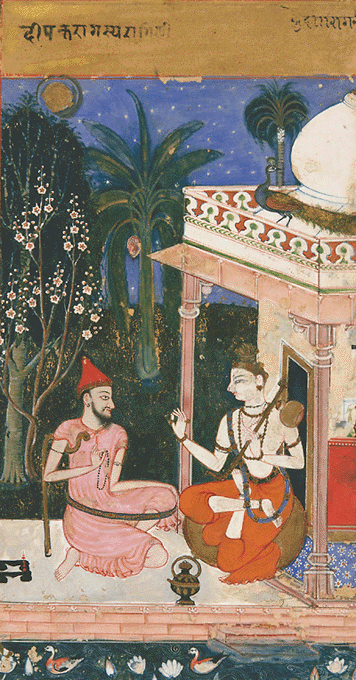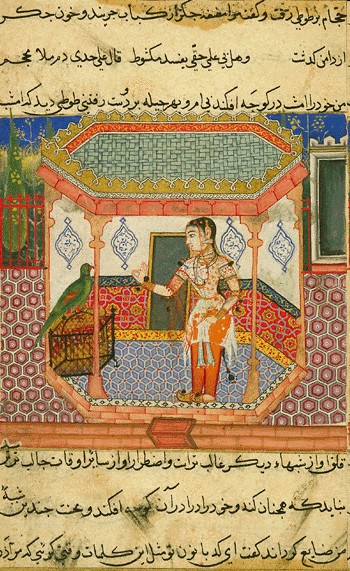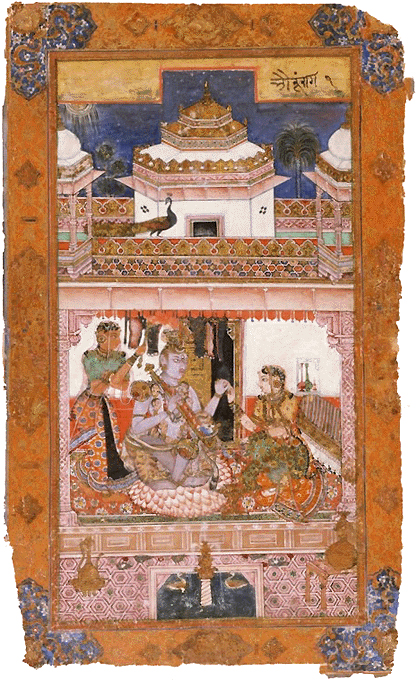
|
|
|
|
The Mughal Influence on Vaisnavism, Part 5
BY: SUN STAFF

Kedar Ragini from the Chunar Ragamala Apr 16, CANADA (SUN) — A serial presentation of the Mughal effect on Vaisnava society. In yesterday's segment we briefly discussed the timeline of Mughal occupation in India, and the fact that India's devotional art schools were variously affected under the reign of successive Mughal rulers. Our study will follow that timeline, beginning with the reign of the first invading emperor to overturn the Sultanate, Babur, who ruled from 1526 to 1530. Babur was followed by Humayun (1530 to 1556), then Akbar (1556 to 1605), Jahangir (1605 - 1627), and finally Shah Jahan (1628 to 1658).
Because Babur's rule was so brief – just over four years – we find only a minimal footprint left on Indian arts and literature during his reign. His successor, Humayun ruled for 26 years, Akbar for 49 years, Jahangir for 22 years, and Shah Jahan for 30 years. Of all these periods, most agree that the greatest impact on the arts was felt under Akbar. The reign of Humayun was interrupted when he was driven out of India for about 15 years, exiled back to Persia. But with the aid of Persian military might, he returned to take back power, bringing with him two highly accomplished Persian artists, Mir-Sayyid Ali and Abd-us-samad. Although Humayun lived for only a year after his return to power in India, these two artists carried on their work under the successive Mughal court's patronage, and they influenced many local Indian artists who took up their style. This gave rise to the Mughal School of painting. Prior to the advent of the Mughal School, Indian devotional art was influenced by Islamic Persian art that was brought to India by both the Sultanate and Babur. This art was primarily in the form of miniature paintings and manuscript illustrations. The earliest known example of Mughal painting is a volume called Tutinama ("Tales of a Parrot'). The original manuscript was done in the 14th century, being a collection of 52 stories and 250 miniature paintings. Later in the 16th century, Akbar commissioned another illustrated version of the manuscript. In the painting below, the woman and the parrot are done in a classic Indian style. The ornamentation and script are Persian and interestingly enough, the four blue designs on the walls are commonly found in Jain manuscripts.

'Tutinama', Tales of a Parrot The stories of Tutinama are credited to a Persian physician and Sufi saint named Nakhshabi, who had migrated to Badayun, Uttar Pradesh in the 14th century. Although he wrote in Persian, he translated a classical Sanskrit version of stories similar to Tutinama into Persian, around 1335 AD. This thin volume of stories, moralistic in theme, are thought to have influenced Akbar in his early years. Eventually the Persian style of miniatures became a prominent expression in Mughal painting, and many Vaisnava themes were done in this style. There was also considerable cross-over between Vedic devotional themes and the style of Persian illustrations. Because high quality paper was a sought after commodity among India's artists, many Indian devotional paintings were done overtop old Persian manuscript leafs. The Mughal miniatures, beginning with the reign of Humayun, primarily depicted court life, battle and hunting scenes. These were painted with very fine brushes in opaque inks, beautifully rendered, although the content is uninspiring from a spiritual standpoint. Later, after the Mughal Empire collapsed, Krsna lila scenes again proliferated in the form of miniature paintings. Many of these artists were under the patronage of the princely Hindu states of Rajasthan, and from 1750 A.D. onwards, their work branched out into many wonderful new schools of devotional art. One of the most notable post-Mughal schools was the Bikaner School, which we'll discuss in more detail in future segments. Our readers will certainly recognize the Bikaner style, many examples of which have graced the Sun's pages over the years. In fact, this classical style of Vaisnava painting is one of our personal favorites. But well before this, in the early days of the Mughal occupation, an important school of art emerged near the Bikaner area, in the vicinity of Uniara, Indergarh and Sarola. This school became known as the Bundi-Kota kalam, and it represents an important transition point in the merging of Islamic and Vaisnava arts. Perhaps the best known example of this intersection of influences is the Chunar Ragamala, painted around 1561 A.D., in the early days of Akbar's rule. This would be about 35 years into the total 132 year span of Mughal rule in India. The Chunar Ragamala paintings depict a strong Mughal influence, and the characteristics and iconography of the style carried forward long after the decline of the Mughal Empire.

Bhairava Raga, Chunar Ragamala The two paintings shown above from the Chunar Ragamala represent an important piece of the puzzle, linking the Mughal School paintings to the Rajput School. The manuscript illustrations were produced by three Islamic artists trained in the Imperial Mughal court. This Ragamala series was produced for Rao Raja Bhoj Singh at his estate at Chunar, in Uttar Pradesh. The series was later taken to the Rao Raja's kingdom at Bundi, Rajasthan. These paintings served as the compositional model for Vaisnava ragamalas produced in the Bundi region for the next 200 years. The painting at the top of this page, Kedar Ragini, depicts a female ascetic in meditation. She is visited by a Muslim darvish. This is a theme seen in many Bundi ragamalas to follow. Both the Kedar Ragini and the Bhairava Raga paintings above clearly incorporate Vaisnava themes. In Kedar Ragini, the visiting Muslim is engaged in yoga practice and is chanting on japa mala. The garlanded yogini holds a veena. Her bhajan kutir is constructed in a distinctly Muslim style, with an onion-shaped dome. In the Bhairava Raga painting we see both Islamic and Vedic architectural styles, with a mix of iconography from both traditions. Here we see Bhairava Shiva with his consort Bhairavi (Parvati), in a peaceful mood. The borders and corner work of this painting are distinctly Persian, but the main theme is Vaisnava. The convergence of artistic styles represented by the Chunar Ragamala paintings is an important link between traditional Vedic and Islamic themes and styles, but it is not the only such link. In tomorrow's segment, we'll compare the style of paintings done in Babur's court with later illustrations of Krsna lila scenes appearing in the Harivamsa.
| |